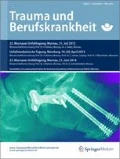Zusammenfassung
Hintergrund
In einer retrospektiven Untersuchung wurden die Langzeitergebnisse von 181 operativ versorgten Kalkaneusfrakturen unterschiedlicher Schweregrade kontrolliert. Ziel war es, die Qualität des Behandlungsschemas des BUKH (Berufsgenossenschaftliches Unfallkrankenhaus Hamburg) zu überprüfen.
Methode
Es erfolgten die Analyse der Röntgen- und CT-Diagnostik (CT: Computertomografie) im prä-/postoperativen Vergleich, eine klinische Untersuchung sowie die Analyse anhand zweier standardisierter Erhebungsbögen [AOFAS („American Orthopaedic Foot and Ankle Society“), MFS („Maryland Foot Score“)] zu Funktion und Belastbarkeit.
Ergebnisse
Besonderes Augenmerk wurde auf die Gruppen der Trümmerfrakturen gelegt (Sanders IV, Zwipp 11 und 12 Punkte). Hierbei konnte herausgearbeitet werden, dass die primäre Arthrodese allenfalls als Ausnahmeindikation angesehen werden kann, in der regelmäßigen Versorgung der Kalkaneustrümmerfraktur jedoch keine Bedeutung hat. Weiterhin wurde das Auftreten von Refrakturen anamnestiziert, um einen Anhalt für die langfristige Stabilität zu erhalten. Hier konnte dargestellt werden, dass auch bei Verzicht auf eine primäre Spongiosaplastik keine eingeschränkte Stabilität bezüglich des Ausheilungsergebnisses festzustellen ist.
Abstract
Background
The long-term outcome (follow-up 82–154 months) of 167 patients with 181 displaced calcaneal fractures treated by open reduction and internal fixation (ORIF) in a level I trauma center (Berufsgenossenschaftliches Unfallkrankenhaus Hamburg, from January 2000 to December 2005) was analyzed in a retrospective cohort study.
Methods
The study involved a comparative analysis of the preoperative and postoperative X-ray and computed tomography (CT) images, a clinical examination and the analysis by two standardized questionnaires, the American Orthopedic Foot and Ankle Society (AOFAS) and the Maryland foot score (MFS) on function and load bearing.
Results
A special focus was on displaced, intra-articular calcaneal fractures (classified as Sanders type IV and Zwipp grades 11 and 12 points). Treatment results were not directly affected by injury severity. Only ten patients were in need of subtalar arthrodesis in the follow-up. A primary subtalar fusion was avoided and should only be an option in exceptional cases. Also primary bone grafting for defect filling appears unnecessary and was not implemented. No malunions, nonunions or refractures were detected.



Literatur
Böhler L (1931) Diagnosis, pathology and treatment of fractures of the os calcis. J Bone Joint Surg Am 13:75–89
Buch J, Blauensteiner W, Scherafati T et al (1989) Konservative Behandlung des Fersenbeinbruches versus Reposition und perkutane Bohrdrahtfixation. Unfallchirurg 92:595–603
Buckley RB, Tough S, McCormack R et al (2002) Operative compared with nonoperative treatment of displaced intra-articular calcaneal fractures. J Bone Joint Surg Am 10:1733–1744
Essex-Lopresti P (1952) The mechanism, reduction, technique and results in fractures of the os calcis. Br J Surg 39:395–419
Hall MC, Pennal GF (1960) Primary subtalar arthrodesis in the treatment of severe fractures of the calcaneum. J Bone Joint Surg Br 42-B(2):336–343
Holz F (2000) Erfahrungen mit der Osteosynthese bei Fersenbeinfrakturen. Trauma Berufskrankh [Suppl 4] 2:S442–S447
Hüfner T, Geerling J, Gerich T et al (2007) Offene Reposition und Osteosynthese mit primärer subtalarer Arthrodese bei intraartikulärer Kalkaneusfraktur. Oper Orthop Traumatol 2:155–169
Illert T, Rammelt S, Drewes T et al (2011) Stability of locking and non-locking plates in an osteoporotic calcaneal fracture model. Foot Ankle Int 32:307–313
Imhoff A, Zollinger-Kiess H (2004) Fußchirurgie. Thieme, Stuttgart
Kitaoka HB, Alexander IJ, Adelaar RS et al (1994) Clinical rating system for the ankle, hindfoot, midfoot, hallux and lesser toes. Foot Ankle Int 15:349–353
López-Oliva F, Sánchez-Lorente T, Fuentes-Sanz A et al (2012) Primary fusion in worker’s compensation intraarticular calcaneus fracture. Prospective study of 169 consecutive cases. Injury [Suppl 2] 43:73–78
Palmer I (1984) The mechanism and treatment of fractures of the calcaneus. Open reduction with the use of cancellous graft. J Bone Joint Surg Am 30:2–8
Potenza V, Caterini R, Farsetti P et al (2010) Primary subtalar arthrodesis for the treatment of comminuted intraarticular calcaneal fractures. Injury 41:702–706
Rammelt S, Zwipp H (2014) Fractures of the calcaneus: current treatment strategies. Acta Chir Orthop Traumatol Cech 81(3):177–196
Richter M, Gosling T, Zech S et al (2005) A comparison of plates with and without locking screws in a calcaneal fracture model. Foot Ankle Int 26:309–319
Sanders R, Fortin P, DiPasquale T, Walling A (1993) Operative treatment in 120 displaced intraarticular calcaneal fractures, results using a prognostic computed tomography scan classification. Clin Orthop Relat Res 290:87–95
Schepers T, Lieshout EMM van, Ginhoven TM von et al (2008) Current concepts in the treatment of intra-articular calcaneal fractures: results of a nationwide survey. Int Orthop 32:711–715
Stephenson JR (1987) Treatment of displaced intra-articular fractures of the calcaneus using medial and lateral approaches, internal fixation, and early motion. J Bone Joint Surg Am 96-A 1:115–130
Wisspeintner S (2009) Die Calcaneusfraktur: Ein Vergleich zwischen offener Reposition/Osteosynthese und geschlossener Reposition/percutane Schraubenosteosynthese. Med. Dissertation, Ludwig-Maximilians-Universität München
Zwipp H, Tscherne H, Wülker N, Grote R (1989) Der intraartikuläre Fersenbeinbruch, Klassifiktion, Bewertung und Operationstechnik. Unfallchirurg 92:117–129
Einhaltung ethischer Richtlinien
Interessenkonflikt. M. Auerswald, D. Rundt, O. Dannenberg, S. Fuchs, C. Jürgens und M. Faschingbauer geben an, dass kein Interessenkonflikt besteht. Alle in diesem Beitrag beschriebenen Untersuchungen am Menschen wurden mit Zustimmung der zuständigen Ethik-Kommission, im Einklang mit nationalem Recht sowie gemäß der Deklaration von Helsinki von 1975 (in der aktuellen, überarbeiteten Fassung) durchgeführt. Von allen beteiligten Patienten liegt eine Einverständniserklärung vor. Alle Patienten, die über Bildmaterial oder anderweitige Angaben innerhalb dieses Beitrags zu identifizieren sind, haben hierzu ihre schriftliche Einwilligung gegeben. Im Falle von nicht mündigen Patienten liegt die Einwilligung eines Erziehungsberechtigen oder des gesetzlich bestellten Betreuers vor.
Author information
Authors and Affiliations
Corresponding author
Rights and permissions
About this article
Cite this article
Auerswald, M., Rundt, D., Dannenberg, O. et al. Langzeitergebnisse und Behandlungsvorschläge bei Kalkaneusfrakturen. Trauma Berufskrankh 16, 161–166 (2014). https://doi.org/10.1007/s10039-014-2130-2
Published:
Issue Date:
DOI: https://doi.org/10.1007/s10039-014-2130-2

